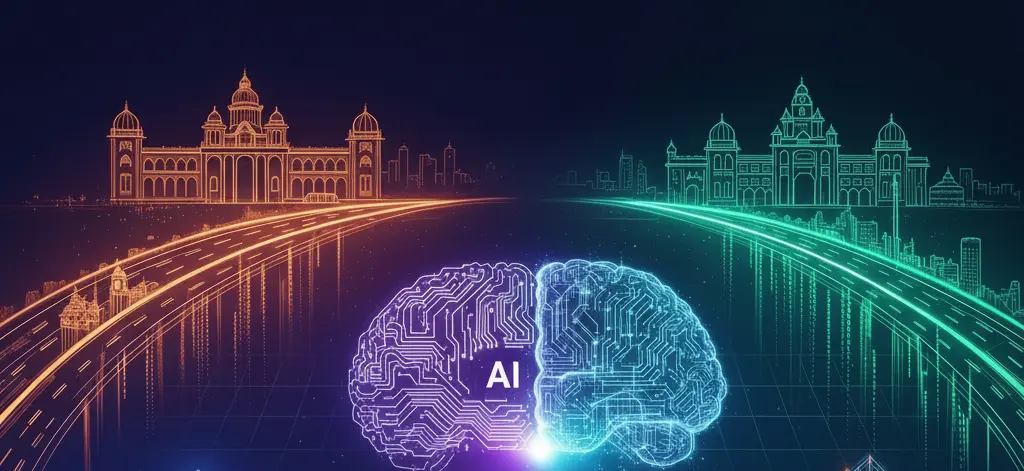Introduction
As India moves from AI pilots to production at scale, Karnataka is pairing ambition with solid execution. The state has built a policy stack spanning information technology, startups, data centres, and electronics manufacturing that gives departments and companies reliable compute, reusable data, and industry-ready talent to solve real problems. Efforts beyond Bengaluru are just as important: new tech clusters in tier-2/3 cities are spreading opportunity, while open-data and interoperability initiatives make government information easier to discover and reuse. Taken together, these choices shift AI from proofs-of-concept to citizen-visible services in classrooms, at government counters, and on busy corridors at rush hour.
Improve Governance & Workforce Management
AI Document Access Platform (Citizen & Staff)
What it is (concrete rollout):
Led by the Centre for e-Governance, the platform begins with a pilot across several high-touch departments and then expands to the public. It offers a single, searchable window for government orders, circulars, and notifications, with simple keyword queries from departmental sites. Version control surfaces the latest document first, and legacy records—including pre-Independence material—are ingested so staff and citizens quickly reach the correct, current reference.
Problems solved:
The platform cuts search time, reduces outdated citations, speeds compliance in field offices, and lowers citizen footfall for routine queries.
Attendance & Workforce Productivity
Government schools: Mobile, AI-based facial recognition (state-wide)
What it is (concrete rollout):
From the 2025–26 academic year, all government and aided schools deploy a mobile app that uses on-device AI for fast, class-level attendance. The system integrates with SATS and supports offline capture with later sync so low-bandwidth schools are included.
Problems solved:
The shift curbs proxy attendance, removes manual muster collation, and gives administrators near real-time visibility at block and district levels, enabling early action on chronic absenteeism.
Government employees: KAAMS (AI-powered selfie-based attendance)
What it is (concrete rollout):
Across all 70 departments and 5+ lakh employees, attendance is captured in real time via on-premise selfies with geofencing and liveness checks, flowing directly into HR/leave systems.
Problems solved:
KAAMS closes swipe/fingerprint loopholes, speeds muster consolidation, and gives supervisors a clear, unit-wise punctuality view.
Nipuna Karnataka (State-wide, Future-Ready Skilling)
Training is demand-led and employer-aligned across AI/ML & GenAI, data engineering/analytics, cloud & DevOps, cybersecurity, robotics/automation, semiconductors, EV & battery systems, drones & GIS, med-tech, green energy, gaming/VFX, and advanced manufacturing. Learners stack micro-credentials that count toward diplomas, bootcamps lead into paid apprenticeships, blended learning eases participation for working learners, and inclusion measures—women-first cohorts, PWD accessibility, and scholarships—lower barriers.
What’s changing on the ground.
Graduates enter AI-adjacent roles faster, certification and placement improve, and MSMEs digitise more confidently with hands-on support.
Shiksha Copilot (GenAI for Teachers)
Problem being solved:
Teachers spend excessive time on lesson prep and assessments, quality varies across classrooms, and targeted remediation at scale is hard.
AI-driven response & how it works:
Shiksha Copilot is a teacher-in-the-loop assistant that drafts syllabus-aligned lesson plans, worksheets, quizzes, differentiated activities, and rubrics. It provides rapid item creation and item analysis, Kannada/English support, low-ink printables, and offline packs for limited connectivity. Privacy and quality are enforced through teacher review, bias/safety checks, and audit trails.
What’s changing on the ground.
Preparation time drops sharply, materials become more consistent, differentiation improves, and formative assessment is easier to run and track.
Bengaluru Adaptive Traffic Control System (BATCS)
Problem being solved:
Bengaluru’s junctions suffer unpredictable delays, emergency-vehicle holdups, and higher crash risk, with fuel waste and emissions as a consequence.
AI-driven response & how it works:
Sensors and cameras feed live data to junction controllers that retime signals dynamically and coordinate green waves across corridors. A central command manages real-time oversight and incident response, while features such as emergency-vehicle pre-emption and bus-priority windows support safety and public transport reliability.
What’s changing on the ground:
Average delays and stops decline, travel times become predictable, bus reliability improves, and fuel use and emissions fall. Safer junctions follow from calmer flows and faster response.
AI Centres of Excellence (Bengaluru)
The CoEs provide shared GPU clusters, a model library, and MLOps pipelines in secure sandboxes. A data commons hosts de-identified public datasets (mobility, health, agriculture, sustainability) with clear licensing. Applied testbeds allow near-real trials, accelerators and procurement sandboxes help agencies adopt what works, and a Responsible-AI lab supports bias testing, red-teaming, and practical playbooks.
What’s changing on the ground.
Time-to-deployment shortens, pilot-to-scale conversion rises, and job creation strengthens as solutions move beyond demos into everyday use.
What’s Next → AI-Powered Mega Township at Bidadi
The Greater Bengaluru Integrated Township (Bidadi) is envisioned as an AI-ready urban district with smart utilities, resilient mobility, green buildings, and an industry corridor designed to catalyse jobs and productivity.
Early focus areas.
AI-assisted city operations for energy, water, waste, and safety; district cooling and smart microgrids; autonomous/connected mobility pilots; and digital twins to guide land-use and infrastructure decisions in real time.
Design principles.
Transparent land and environmental processes, inclusive engagement with local communities, and tight linkages to the state skilling and innovation ecosystem so skills, firms, and jobs reinforce one another.
Conclusion
Karnataka’s AI story is about building the plumbing first—policies, infrastructure, datasets, and skills—and then using it to fix practical problems. Talent programmes help people step into new roles; Shiksha Copilot lifts classroom quality; BATCS makes commutes bearable and safer; and the AI CoEs give innovators the compute, data, and pathways they need to ship responsibly. The Bidadi township extends this logic to urban design, tying skills, industry, infrastructure, and day-to-day city operations into one coherent plan. Together, these moves show how a state can turn AI into everyday public value—reliably, inclusively, and at scale.

